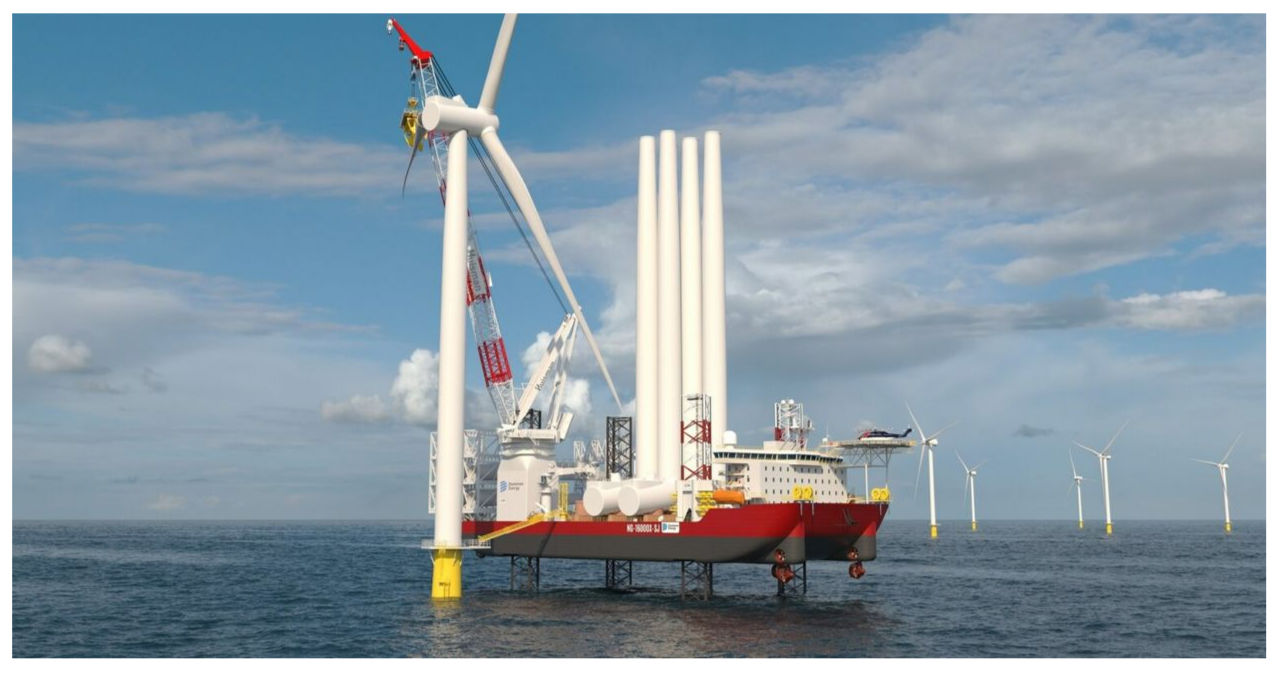Dominion Energy has unveiled its planned offshore wind installation vessel, Charybdis, in a rendering.
Charybdis, the Greek sea monster that posed challenges for Odysseus in his epic journey in The Odyssey, has now become the name of Dominion Energy’s latest addition – a 471-foot ship. This vessel will play a crucial role in the construction of the Coastal Virginia Offshore Wind project, which happens to be the largest project of its kind in the entire country.
On Monday, Dominion made an exciting announcement that the 23,000-ton ship had been successfully lifted from land, rolled to the edge of a dock, and carefully placed in the water. This marks an important milestone in the ship’s construction journey, as it will now undergo further work to complete it by late 2024.
In addition to this significant progress, there was more good news as the U.S. Environmental Protection Agency granted approval for the 11th and final federal permit required for the CVOW construction to commence. This means that the construction process, which will begin with the installation of foundational supports known as monopiles in May, is now ready to kick off.
Bob Blue, the chair, president, and chief executive officer of Dominion Energy, emphasized the significance of the Charybdis in relation to CVOW and the expansion of the offshore wind industry. He highlighted that it plays a crucial role in the development of a domestic supply chain by offering a local solution for installing offshore wind turbines.
The Coastal Virginia Offshore Wind project is set to be completed by the end of 2026. This ambitious project involves the installation of a 176-turbine wind farm situated 27 miles off the coast of Virginia Beach.
The $9.8 billion project, approved by Dominion’s regulators, the State Corporation Commission, is expected to generate sufficient electricity to power 660,000 homes. This project aligns with the Virginia Clean Economy Act and supports the state’s objective to decarbonize the grid by mid-century.
According to Dominion Spokesperson Jeremy Slayton, the Charybdis vessel will adhere to the Jones Act, eliminating the need for Dominion to depend on a foreign-flagged ship from another country to provide the necessary parts for the construction of CVOW.
Cargo transported between U.S. locations must abide by the Jones Act, which requires it to be carried on a vessel that is built, owned, and operated by the United States. This regulation serves to enhance both the economic security and national defense of the country.
According to Slayton, once the monopile is installed to support the wind turbines, it becomes a focal point.
Dominion would have had to construct the CVOW without the Jones Act-compliant Charybdis, following a process similar to how it built its first two test turbines. This would involve staging the components in Canada before shipping them down and installing them. Alternatively, Dominion could have used floating barges to transport the wind turbine components out to sea, as suggested by Slayton.
Using barges for the construction of the 367 feet tall turbines poses a challenge due to the instability caused by the ebbs and flows of the sea, according to Slayton. However, Charybdis offers a solution by extending four legs down to the sea floor, which ranges from about 75 feet to 125 feet deep. This allows the ship to be lifted above the water, keeping it out of reach of the sea’s waves.
Charybdis will feature a crane that will assist in the installation of towers, including the monopiles, as well as the 14.6 megawatt wind turbines and other necessary components.
The construction of the vessel is currently underway at Seatrium’s AMFELS shipyard in Brownsville, Texas. The shipyard is utilizing steel sourced from the United States, and the project has created employment opportunities for approximately 1,200 workers. The completion and delivery of the vessel to the Hampton Roads area are anticipated to take place by late 2025.
“The construction of this ship in the United States will not only help to ensure a steady, cost-effective, and environmentally friendly energy supply, but it will also have a positive impact on local communities by providing valuable expertise and job opportunities,” stated Chris Ong, the CEO of Seatrium.
The Charybdis system is not only limited to its role in constructing the CVOW project. It has a broader purpose of being employed in various offshore wind initiatives across the United States.
Dominion’s shareholders are investing approximately $625 million to construct the ship. Subsequently, ratepayers will support the ongoing utilization of Charybdis as part of the comprehensive CVOW construction expenses. These costs will be retrieved through the monthly Rider OSW rate adjustment clause added to customers’ bills. The anticipated rider amount for the average residential customer is around $4 per month throughout the project’s 35-year lifespan.



